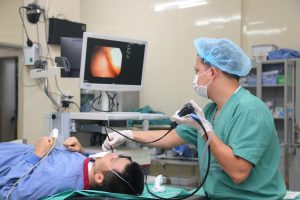Vietnam achieves new success in organ transplantation
12/08/2024 16:52
Doctors at Viet Duc Friendship Hospital have successfully performed a groundbreaking surgery, transplanting a trachea segment from a brain-dead donor and reconstructing an oesophageal structure for a patient from Thanh Hoa Province. This is the first time this rare case in the world of medicine has been successfully performed in Vietnam.

Doctors at Viet Duc Friendship Hospital re-examine and re-evaluate the patient following tracheal transplantation and oesophageal reconstruction.
The patient is a young man L.V.N (25 years old, Thanh Hoa) with complicated injuries, tracheal stenosis near the glottis, fistula and oesophageal stenosis after a traffic accident.
Two years ago, L.V.N unfortunately suffered a traffic accident that led to multiple traumatic brain injuries, maxillofacial injuries, closed chest injuries, liver injuries… and underwent surgery to combine the maxillofacial bones, neck area and conservative treatment of other damaged organs. After surgery, the patient was monitored and treated intensively (with tracheostomy). When in stable condition, he was transferred to a local hospital for further treatment.
One month after the tracheostomy, the patient was given consultation for conservative treatment, including dilation and placement of a tracheal stent, followed by tracheal resection surgery, but it was unsuccessful due to complex damage and narrowing of a long section of the trachea. After about two months, the patient experienced difficulty breathing and had to have the tracheostomy permanently reopened.
During the treatment of cervical tracheostomy, when the tracheostomy had not yet been performed, the patient ate and drank normally by mouth and received anti-scarring injections, but the patient had fluid leaking through the tracheostomy site. Gastroenterologists diagnosed a tracheoesophageal fistula at the anti-scarring injection site of the tracheostomy and performed a gastrostomy for feeding.
For more than a year, the patient has not been able to eat by mouth (he must be fed through a gastric tube), and has not breathed through the nose but through the tracheostomy in the neck. The patient and his family were very pessimistic about the future of the young man, who was able to work but was now disabled; his life was at a standstill.
The results of the oesophageal endoscopy at Viet Duc Friendship Hospital showed a completely narrowed segment 16 cm from the upper dental arch; the oesophageal orifice was smooth, the endoscope was inserted about 2 cm down, the oesophageal lumen had a narrow scar tissue around it, causing narrowing of the entire circumference, the narrowing did not improve after dilation, and at the same time, when the endoscope was inserted through the nose through the trachea, there were signs of suspected vocal cord paralysis.
Laryngopharyngeal CT scan showed a ruptured laryngeal cartilage frame causing narrowing of the larynx, the trachea was opened at the level of the fourth and fifth cervical spine. The injury to the trachea was about 6.5 cm long, close to the glottis.
Given the patient’s complicated injuries, the doctors held an interdisciplinary consultation (ENT, gastroenterology, thoracic surgery, rehabilitation, anesthesia, tissue bank, nutrition, etc.) and agreed to perform two-stage surgery (two sessions). One surgery was to reconstruct the narrowed cervical oesophagus or reconstruct the oesophagus using a colon segment. The other surgery was to reconstruct the glottis segment combined with grafting the cervical trachea segment using a trachea segment donated by a brain-dead donor (available at the Tissue Bank).
With careful preparation by the team of leading experts from Viet Duc Friendship Hospital, the patient underwent surgery to reconstruct the cervical oesophagus, cut the fibrotic scar of the trachea on April 11, 2024, and prepare both ends of the trachea for the next surgery. On May 13, 2024, the patient underwent cervical tracheal transplantation using the trachea of a brain-dead donor combined with tracheal stent placement and bilateral sternocleidomastoid muscle transposition to cover the transplanted tracheal segment.
The surgery was initially successful. After a period of active treatment, the patient was discharged from the hospital and returned home on June 25, 2024. The results of a follow-up examination after one month showed that the patient’s physical condition had been gradually improving (gained 5 kg), and the surgical scar was healing well. Notably, the patient could eat and drink by mouth and breathe through the nose. The results of the esophagogastroduodenoscopy showed that the surgical scar healed well, the transplanted trachea segment was pink, not congested, not necrotic, not stenotic.
The results of the follow-up examination three months after surgery showed that the patient had gained 10 kg with a healthy overall condition, breathing through the nose and eating through the mouth. The test results on August 7 showed that the patient had completely changed, gaining further weight and improved health, and was able to eat by mouth and breathe through the nose. It is expected that after the tracheal stent is removed (in about 1-2 months), the patient’s life will return to normal.
Dr. Duong Duc Hung, Director of Viet Duc Friendship Hospital, shared that up to now, tracheal transplantation in general and airway transplantation in particular are still a challenge in the surgical field as well as in the medical community around the world. Through research, there are only a few short reports on tracheal transplantation, but the success rate is not high, there is no most-effective method to handle this type of injury. Currently, there are only about 10 reports on similar transplantations in the world.
In September 2007, doctors at Viet Duc Friendship Hospital also successfully performed an autologous tracheal transplantation for a patient by taking a segment of the patient’s renal aorta and grafting it onto their trachea. This time, it was a transplant from a brain-dead donor, which is much more complicated. In addition to having two injuries at the same time (both trachea and oesophagus), the choice of treatment method for two types of injuries, the choice of graft material, the time of operation, the anaesthesia plan, post-operative care, the care of the transplanted trachea segment, and so on, were carefully calculated.
All of the above issues are always raised during the consultation process, but they are also valuable experiences for performing complex transplants in the future. The success of this surgery opens the door to treatment opportunities, improving the quality of life for cases of long tracheal injuries (due to trauma, congenital stenosis or tumors) that can restore the best airway.
Viet Duc Friendship Hospital has identified organ transplantation as a development focus in the coming time. In addition to more routine implementation of liver, heart, kidney, and lung transplants, the hospital will implement transplants of many other organs such as pancreas, intestines, and more.
Source: https://en.nhandan.vn/vietnam-achieves-new-success-in-organ-transplantation-post138188.html
QUANG MINH – nhandan.vn
Translated by NDO











